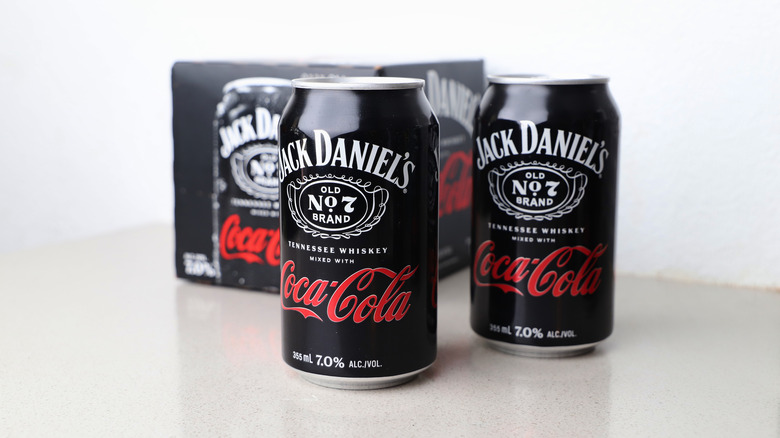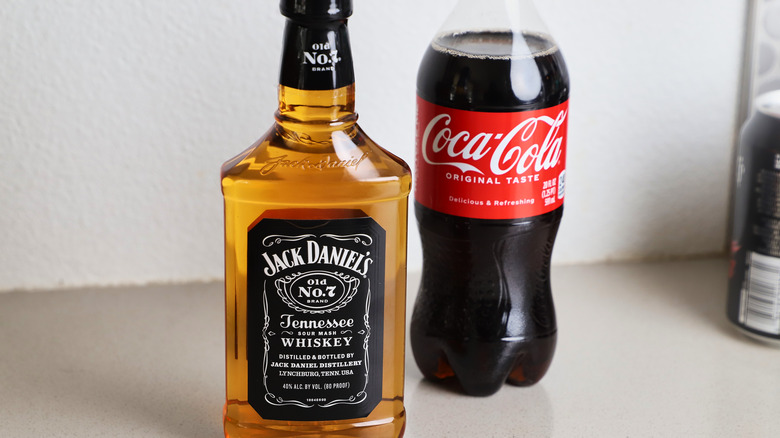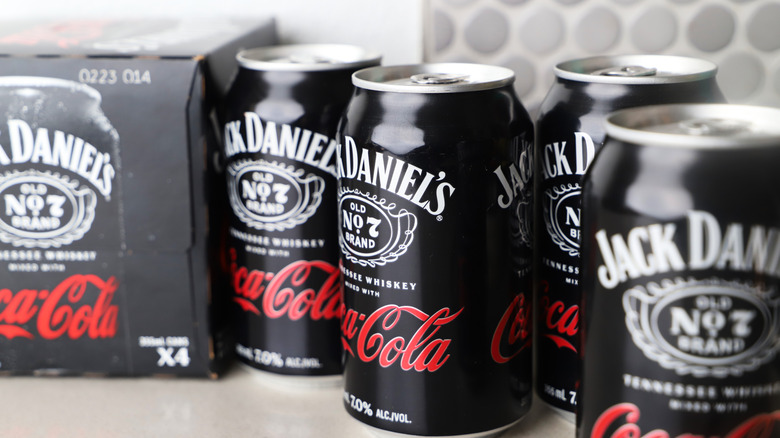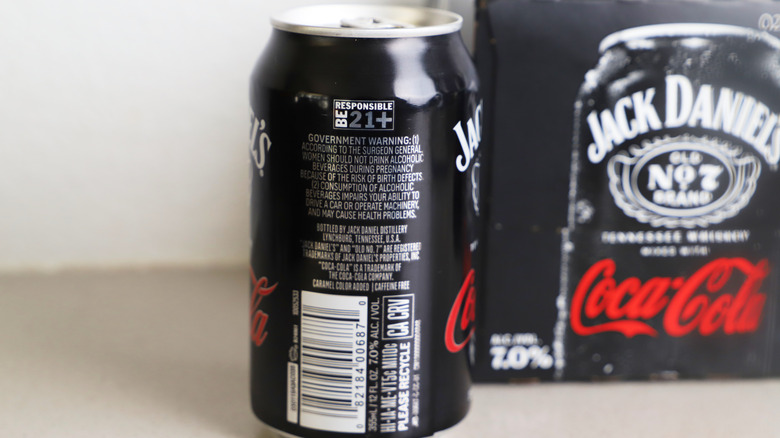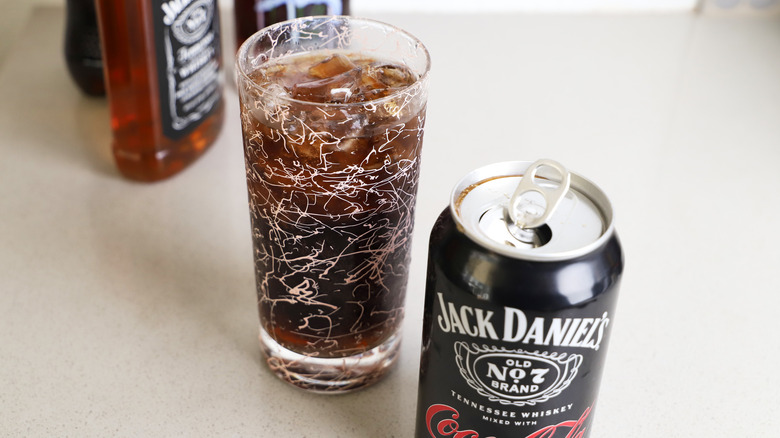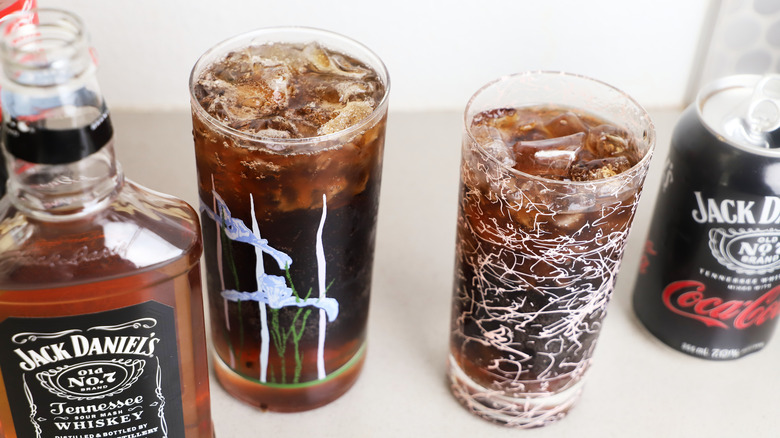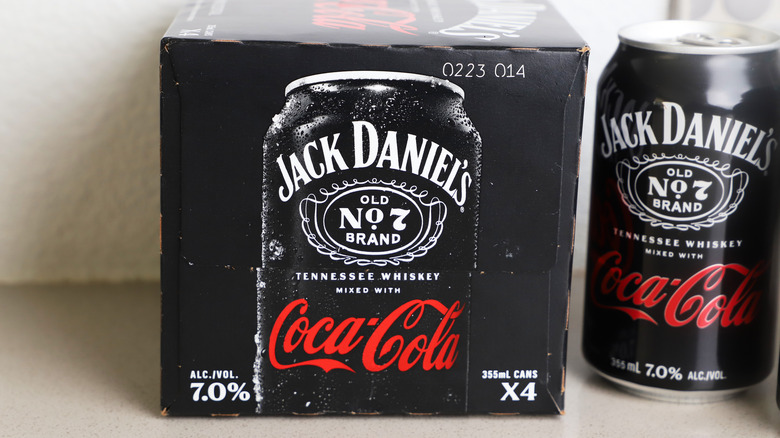Review: Canned Jack & Coke Is Great On The Go, But Falls Short Of Scratch-Made
The trend of batched canned cocktails has swollen from a small-batch boutique brand like Portland, Oregon's Straightaway Cocktails, and the more niche probiotic-laden, JuneShine Hard Kombucha to mainstream shelves of conventional grocery and liquor stores everywhere. This summer consumers can grab stubby bottles of Red Stripe Rum and Coke, a somewhat shocking Sunny Delight foray into the alcohol market, and now a Jack Daniels and Coca-Cola co-brand of its ubiquitous medley of Jack and Coke.
Branded as a "Ready to Drink," or "RTD" cocktail for short, it originally launched last fall in Mexico, according to Coca-Cola's official website, and now the concoction makes its way into the U.S. market before summer's cooler-heavy, barbecue season. But, even to the bar novice, the notion of a pre-mixed Jack Daniels and Coca-Cola may seem a little superfluous, considering the almost foolproof construction of the two-element cocktail, highlighted by even its nomenclature.
So, to test drive these new-to-market portable cocktails, we filled up a highball glass with ice and crushed a couple of cans of the latest commodity under Coca-Cola's growing banner of its beverage line which early this year brought us both Coca-Cola Starlight and Coca-Cola Transformation (non-alcoholic) flavors.
A quick history of Jack & Coke
How did Jack Daniels first kiss the carbonated waters of Coca-Cola's soft drink? According to Coca-Cola's own website, the two brands both sprung up in the late 1800s; Jack Daniels in 1866 in Tennessee, and Coca-Cola 20 years later in 1886 out of Georgia. So the cross-pollination of the two Southern brands feels as organic as a pairing of Chardonnay and seafood. However, when we dug a little deeper, we realized that, along with geography, the prohibition era played a role in the two drink's long marriage.
The aftershock of the 13-year period of prohibition continues to reverberate through bar culture today. Still, during the nationwide alcohol ban, unsanctioned bars or speakeasies encouraged guests to request specific brands of liquors to sashay the pouring of unsafe, rotgut (poor-quality) liquors. Thus brands like Bacardi, Maker's Mark, Jim Beam, and, of course, Jack Daniels ran across the tongues of the masses looking to imbibe on the down-low, thus making colloquialisms of drink calls like "7 and 7" (Seagram's 7 Crown Whiskey a 7-Up), "Captain and Coke," (Captain Morgan Rum and Coca-Cola), and "Jack and Coke." The simplistic cocktail's longevity owes its continued prominence to the hellaciously sweet soda and the Tennessee bourbon's caramel undertones matching each other's spicy, vanilla balancing act without interrupting either beverage's bare form.
Where can you get it and how much is it?
Hovering around $13 to $15 for a mini-case of four 355-milliliter cans, Jack Daniel's and Coca-Cola's cobranded can is now ready to be added to your shopping cart in major grocery stores nationwide, including heavy-hitters like Target and Safeway. However, if you live in a controlled state where liquor laws ban the purchasing of hard alcohol in convenience and grocery stores intended for all ages (like Oregon, Idaho, Montana, and a handful of others), consumers looking to sip from a Jack Daniels and Coca-Cola branded cans will have to make a special stop at one of their state-run liquor stores to track down a black box of canned cocktails.
Fairly priced when considering the cost of half or demi-bottle of Jack Daniel's Old No. 7 Tennessee Whiskey (around $15), and a 20-ounce bottle of Coca-Cola (about $2), the breakdown evens out whether you choose to purchase the pre-made cocktail or go au natural and stir up your own. Since a 375-milliliter bottle contains eight 2-ounce shots of whiskey, surprisingly, the co-branding isn't trying to eke out much extra cash from pre-mixing and packaging its batched cocktail. It seems to be going more for convenience, incentivizing the new cans over the old-school, DIY-version of a Jack and Coke.
What's in the can
Though both the Jack and Coke pre-mixed can and box boast the drinks' alcohol content (7%), and the legal government warning branded on all beverages containing liquor, they can somehow avoid imprinting the can with a further ingredient list or nutritional facts.
Notably, the can states that its contents are "caffeine-free." That's a significant ingredient listed on a classic Coca-Cola bottle, we're guessing the Jack Daniels co-brand might use a variation of Coca-Cola's Caffeine-Free version of the brand's soda, possibly to avoid any adverse effects from mixing a depressant (alcohol) with a stimulant (caffeine). That said, being able to dodge the nutritional fact label required for soft drinks leads us to rely on the printed information on a bottle of Classic Coca-Cola. We're guessing the brown liquid boasts substantial sugars (high fructose corn syrup).
Combined with a shot of whiskey, we're estimating around 100 calories; a canned Jack and Coke probably set its consumer back around 250 calories as a rough guess. However, due to Coke Zero's popularity, the collaboration between the soft drink and distillery also offers a "zero sugar" version, with the aspartame-sweetened soda, which we reckon could drop the final calorie count to 100 to 150.
Does it taste good?
In a glass chilled with crushed ice, the RTD Jack and Coke tasted mostly as we expected; the melding of bourbon and cola fit recognizably together in a refreshing drink reminiscent of college house parties and chain restaurants. To expect a canned bourbon and Coke to ascend to any higher than a sweet and decent vehicle to hide the burn of mid-level whiskey subtly would be unfounded. Still, after a couple more sips, we found the concoction a little flat on the palate with undertones of an earthy coffee-like note. Perhaps because the two components are completely intertwined, there was an eerie simulacrum effect while sipping it; like it was so close to its intended target, but somehow breezed past it.
Perhaps because the bourbon and sodas have been intertwined before bottling, the finished drink tasted watered down and didn't hold its carbonation for the duration it took us to finish the beverage. Furthermore, something about it made us think our ice was freezer-burnt despite being brand new. However, chilled down and drunk straight from the can, it was more pleasurable and a little less muted. But in that form, it also carries a too big and syrupy mouthfeel and was less refreshing.
Let's compare it with scratch-made Jack & Coke
We built our DIY Jack and Coke directly into a highball glass with 2 ounces of whiskey and a large scoop of ice. We then filled the remaining space with roughly 3 to 4 ounces of Classic Coca-Cola and stirred the mixture with a bar spoon. Like the pre-made cocktail, our homemade Jack and Coke invoke memories of a younger, less experienced drinker and was a sweeter drink than we'd gravitate towards today.
But despite the conviction of Coca-Cola and Jack Daniel's official cobranding, the quality between the two beverages was noticeably disparate. We wonder if whatever element in Coca-Cola that requires caffeine also is a crucial element in harnessing the quintessential Coca-Cola flavor since the uncanny valley we tasted in the ready-to-drink can wasn't present in the at-home version we made ourselves. With the classic Coca-Cola feeling more familiar, the notes behind the bourbon come across more pronounced, and we were able to pick out both brands' specific personalities as opposed to a weird pre-mixed amalgamation of both we tried before.
And, perhaps most importantly, the cold cocktail stayed fizzier longer and remained (besides the melting of the ice) as intact as it was when we first mixed it throughout our sipping. While the entire experiment made us realize the leaps we've taken since our early days of drinking, we walked away from it still recognizing a Jack and Coke as a simple, cocktail viable for house parties and potlucks.
Is it worth it?
If all you really care about is the monetary value of the latest output from Coca-Cola, then, yes, the Jack and Coke co-brand is technically worth your money. In no way does it seem like either company is trying to pull the wool over its thirsty consumers and somehow give customers less than what they're paying for.
But if you're a Jack and Coke enthusiast and it's your go-to beverage once you kick off your shoes, then substituting the ready-to-drink Jack Daniels and Coca-Cola co-brand will feel somehow eerie and unremarkable compared to your regular order. It's as if someone attempted to switch your Sprite to 7-Up, and there's a noticeable shift in flavor when relying on the easier option.
As for our remaining cans of Jack and Coke, they're far from destined for the trash room of our building. With summer poking around the corner, we do expect them to come in handy once picnics, campouts, and potlucks begin to take hold of our social calendar. Completely drinkable, although a little uncanny, we're more curious if this Jack and Coke can will open the doors for more unique canned cocktails from the soda giant because, at the end of the day, a pre-made Jack and Coke can't help but feel as lazy as the idea itself.
